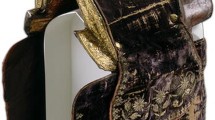Abstract
The incidence and types of sella and sphenopetrous bridges were investigated in 37 adult male and 43 adult female (a total of 80) dry skulls with removed calvarias. In addition to this, the sellar and parasellar region of ten fixed cadavers (two female and eight male) were carefully dissected, and the individuals were examined for the evidence of sella and sphenopetrous bridges. Sella bridges were seen in 34.17% of the subjects overall. The trace, incomplete and complete types were 11.9%, 3.7% and 17.5%, respectively. On the other hand, sphenopetrous bridges were observed in 15.8% of the male and 4.9% of the female subjects overall. The cadaveric investigation revealed one trace, three incomplete, and one complete sella bridge in three cadavers. In addition to this, a complete sphenopetrous bridge was detected in one of the cadavers. Variations in the cranial base are of importance for surgical approaches in that location.




Similar content being viewed by others
References
Agati D (1940) Selle turciche di frenopatici. Rilievo anatomo-radiografico su 196 crani di frenopatici. Arch Radiol 16:5–23
Bergerhoff W (1964) Atlas anatomischer Varianten des Schädels im Röntgenbild. Springer, Berlin Heidelberg New York
De Villiers H (1968) The skull of the African Negro. Witwaters University Press, Johannesburg
Destrieux C, Velut S, Kakou MK, Lefrancq T, Arbeille B, Santini JJ (1997) A new concept in Dorello’s canal microanatomy: the petroclival venous confluence. J Neurosurg 87:67–72
Dodo Y, Ishida H (1987) Incidences of nonmetrical cranial variants in several population samples from East Asia and North America. J Anthropol Soc Nippon 95:161–177
Hauser G, De Stefano GF (1989) Epigenetic variants of the human skull. E Schweizerbartsche Verlagsbuchhandlung (Nageleu. Obermiller), Stuttgart
Hochstetter F (1940) Toldts Anatomischer Atlas, vol 1, 18th edn. Urban & Schwarzenberg, Berlin Wien
Inoue T, Rhoton Jr. AL, Theele D, Barry ME (1990) Surgical approaches to the cavernous sinus: a microsurgical study. Neurosurgery 26:903–931
Kinmann J (1977) Surgical aspects of the anatomy of the sphenoidal sinuses and the sella turcica. J Anat 124:541–553
Lang J (1977) Structure and postnatal organization of heretofore uninvestigated and infrequent ossifications of the sella turcica region. Acta Anat 99:121–139
Lang J (1995) Skull base and related structures—atlas of clinical anatomy. Schattauer, Stuttgart
Martin HO (1941) Sella turcica und Konstitution. Thieme, Leipzig
Maxia C (1950) Sul significato morfologico della frequenza dei processi clinoidei e della fusione nel cranio umano. Rass Med Sarda 1:1–7
Ossenberg NS (1970) The influence of artificial cranial deformation on discontinuous morphological traits. Am J Phys Anthropol 33:357–372
Ossenberg NS (1976) Within and between race distances in population studies based on discrete traits of the human skull. Am J Phys Anthropol 45:701–715
Platzer W (1957) Zur Anatomie der “Sellabrücke” und ihrer Beziehung zur Arteria carotis interna. Fortschr Rontgenstr 87:613–616
Samii M, Draf W (1989) Surgery of the skull base (an interdisciplinary approach). Springer, Berlin Heidelberg New York
Schneider AJ (1939) Sellabrücken und Konstitution. Thieme, Leipzig
Umansky F, Elidan J, Valarezo A (1991) Dorello’s canal: a microanatomic study. J Neurosurg 75:294–298
Williams PL, Warwick R, Dyson M, Bannister LH (1993) Gray’s anatomy, 37th edn. ELBS with Churchill Livingstone, Edinburgh
Author information
Authors and Affiliations
Corresponding author
Rights and permissions
About this article
Cite this article
Peker, T., Anıl, A., Gülekon, N. et al. The incidence and types of sella and sphenopetrous bridges. Neurosurg Rev 29, 219–223 (2006). https://doi.org/10.1007/s10143-006-0018-8
Received:
Revised:
Accepted:
Published:
Issue Date:
DOI: https://doi.org/10.1007/s10143-006-0018-8




